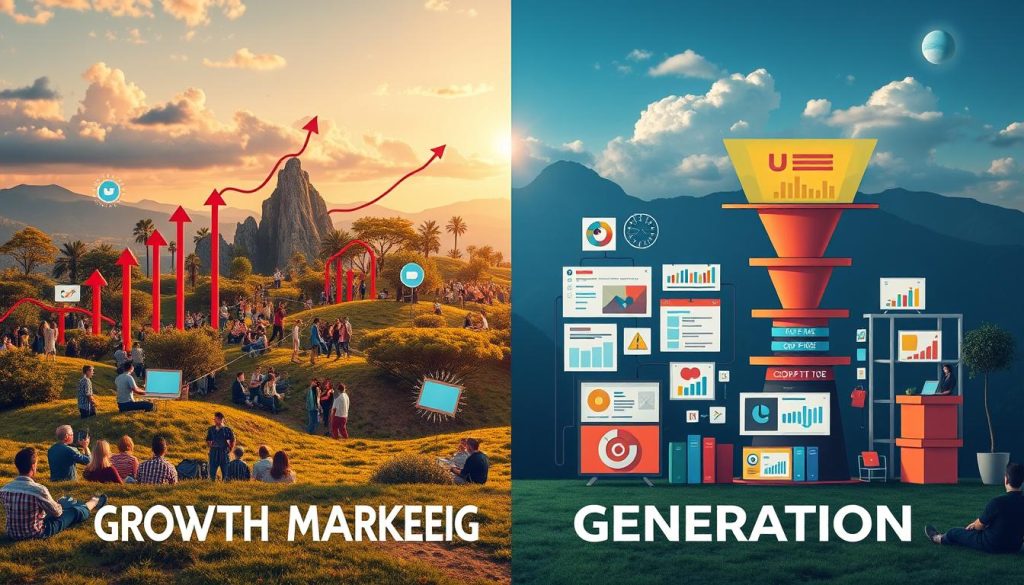Businesses seek strategies to drive growth and maximize returns. Growth marketing and demand generation are two popular approaches. Understanding their differences is key for businesses to choose the best strategy.
Growth marketing, or “growth hacking,” uses rapid, data-driven experiments. It aims to find tactics that quickly scale a business. This agile method tests, measures, and improves to find effective customer acquisition channels.
Demand generation creates a steady pipeline of qualified leads. It combines inbound and outbound marketing efforts. This approach is more comprehensive than growth marketing.
The choice between these approaches can greatly impact a business’s success. Understanding their differences and similarities is crucial. This knowledge helps organizations make informed decisions in a competitive market.
Key Takeaways:
- Growth marketing and demand generation are distinct marketing approaches with different goals and tactics.
- Growth marketing focuses on rapid, data-driven experimentation to scale a business quickly.
- Demand generation creates a steady pipeline of qualified leads through a combination of inbound and outbound marketing efforts.
- The choice between growth marketing and demand generation depends on a business’s unique goals and objectives.
- Understanding the nuances between these two approaches is crucial for businesses to determine the most effective strategy for their success.
Understanding the Fundamentals of Marketing Evolution
Marketing has changed dramatically in the business world. The move from traditional to digital marketing has reshaped how companies attract customers. This shift has redefined lead generation, customer acquisition, and brand awareness strategies.
The Shift from Traditional to Digital Marketing
Traditional marketing methods like print ads and billboards have been replaced. Digital approaches now dominate, offering more targeted and measurable results. Companies use social media, SEO, content marketing, and email campaigns to engage audiences.
Digital marketing provides businesses with valuable data-driven insights. These insights help companies make smarter decisions and improve their marketing strategies.
Why Modern Businesses Need Specialized Marketing Approaches
Today’s competitive market demands more than generic marketing strategies. Modern consumers expect personalized experiences and tailored solutions. Successful companies now use specialized marketing to meet their audience’s unique needs.
Specialized marketing techniques boost lead generation and customer acquisition. They also enhance brand awareness. This approach leads to increased loyalty, higher conversion rates, and a stronger market position.
“The future of marketing lies in the ability to personalize and tailor our approaches to the unique needs of each customer.” – John Doe, Marketing Strategist
What is Growth Marketing: A Comprehensive Overview
Growth marketing is reshaping how businesses connect with customers. It’s a fresh approach to customer acquisition and retention. This strategy is changing the game for companies worldwide.
Growth marketing uses data to drive rapid experiments and scalable tactics. It aims for sustainable business growth. Unlike traditional methods, it focuses on customer-centric approaches and real-time data.
This method uses analytics to find the most effective channels. It then capitalizes on these channels for maximum impact. Growth marketing is all about precision and efficiency.
The key principles of growth marketing include:
- Rapid Experimentation: Growth marketers constantly test new ideas. They measure impact and quickly improve strategies.
- Data-Driven Decision Making: Choices are based on hard data, not assumptions.
- Scalable Tactics: Techniques are designed to reach more customers efficiently.
- Customer Engagement: The focus is on addressing specific audience needs to drive meaningful customer engagement.
Growth marketing unlocks new opportunities for businesses. It leads to sustainable growth and long-term success. Companies can thrive by using data-driven marketing strategies.

Effective growth marketing identifies key customer touchpoints. It then tests and optimizes these points. This process drives better customer engagement and higher conversion rates.
Demand Generation Explained: Core Principles and Strategies
Demand generation creates interest in a company’s products or services. It drives qualified leads and fuels revenue growth. This approach is key to the modern sales funnel.
Key Components of Demand Generation
Successful demand generation includes several connected elements:
- Content creation: Developing engaging, informative, and valuable content that addresses the pain points of your target audience.
- Lead capture: Implementing lead capture mechanisms, such as forms, landing pages, and gated content, to collect contact information from potential customers.
- Lead nurturing: Nurturing these leads through personalized communication and targeted content, guiding them through the sales funnel.
- Multi-channel promotion: Leveraging a mix of digital channels, including social media, email, and search engine optimization, to amplify your demand generation efforts.
The Role of Sales Enablement in Demand Gen
Sales enablement is crucial for demand generation. It aligns sales and marketing teams to boost effectiveness. This teamwork helps drive revenue growth and maximize demand generation strategies.
Measuring Demand Generation Success
Tracking key metrics helps refine and optimize your strategies. Important metrics to monitor include:
- Lead generation rate: The number of new leads captured over a given period.
- Lead-to-opportunity conversion rate: The percentage of leads that convert into sales opportunities.
- Sales funnel velocity: The speed at which leads move through the sales funnel.
- Return on investment (ROI): The overall financial impact of your demand generation activities.
Monitoring these metrics allows for data-driven decisions. This approach helps fine-tune demand generation strategies. Ultimately, it drives sustainable revenue growth for your business.

Growth Marketing vs Demand Generation: Key Differences and Similarities
Growth marketing and demand generation are two distinct marketing strategies. Both aim to drive business growth but use different methods. Understanding their differences is vital for optimizing marketing efforts.
Growth marketing focuses on acquiring new customers quickly. It uses A/B testing, data-driven optimization, and innovative growth hacking techniques. The goal is to rapidly scale a company’s customer base.
Demand generation creates and nurtures qualified leads. It builds brand awareness and cultivates long-term relationships with potential customers. This approach centers on content creation and thought leadership.
| Growth Marketing | Demand Generation |
|---|---|
| Emphasis on rapid customer acquisition | Emphasis on lead generation and nurturing |
| Utilizes data-driven optimization and experimentation | Focuses on content creation and thought leadership |
| Aims to scale the customer base quickly | Seeks to build long-term brand awareness and relationships |
| Metrics: User acquisition, conversion rates, lifetime value | Metrics: Lead generation, lead nurturing, marketing qualified leads |
These approaches can complement each other in a well-rounded marketing strategy. Businesses can use growth marketing to acquire customers quickly. At the same time, they can use demand generation to nurture leads.
Combining these strategies can create a sustainable approach to customer acquisition. It also helps with customer retention and brand building.

The choice between these strategies depends on a company’s needs and growth stage. Smart marketers understand the value of both approaches. They apply them to drive growth and establish a strong brand.
The Impact of Growth Marketing on Customer Acquisition
Growth marketing is a powerful strategy for businesses seeking new customers. It uses a data-driven, customer-centric approach to find growth opportunities. This method helps companies identify and act on the most effective ways to expand.
Growth Hacking Techniques That Drive Results
Growth hacking is a key part of growth marketing. It uses various techniques to quickly test and improve customer acquisition efforts. These methods aim to attract and engage new customers in innovative ways.
Growth hackers excel at finding unique approaches to reach potential clients. They optimize website conversions and use social media influencers to boost visibility. Their goal is to rapidly scale customer acquisition strategies.
- A/B testing to optimize landing pages and user experiences
- Developing targeted social media campaigns to reach new audiences
- Leveraging email marketing and marketing automation to nurture leads
- Exploring unconventional growth channels, such as strategic partnerships
Data-Driven Decision Making in Growth Marketing
Growth marketing focuses heavily on data-driven decisions. It closely monitors key performance indicators (KPIs) and uses analytics to uncover insights. This approach allows for informed, iterative adjustments to strategies.
By constantly optimizing their methods, growth marketers ensure maximum customer acquisition. They use data to guide their choices and improve results over time.
| Key Growth Marketing Metrics | Importance for Customer Acquisition |
|---|---|
| Conversion Rate | Measures the effectiveness of acquisition channels and campaigns |
| Cost per Acquisition (CPA) | Tracks the efficiency of customer acquisition efforts |
| Customer Lifetime Value (CLV) | Provides insight into the long-term value of acquired customers |
Growth marketing combines hacking techniques with data-driven decisions. This approach drives sustainable customer acquisition and fuels business growth. It’s a powerful tool for companies looking to expand their customer base.

How Demand Generation Influences Revenue Growth
Demand generation strategies drive revenue growth by creating a steady flow of qualified leads. These tactics nurture leads through the sales funnel, directly impacting a company’s revenue growth. Effective demand generation increases sales-ready leads entering the pipeline.
Targeted content, personalized outreach, and strategic nurturing campaigns attract potential customers. These methods make the sales team’s job more efficient and effective. Data-driven insights and analytics help optimize marketing efforts.
Companies can refine messaging and allocate resources better with this approach. This leads to a higher return on investment and faster revenue growth. Demand generation also supports the overall sales funnel.
Generating consistent qualified leads fills the top of the funnel. This ensures a steady stream of potential customers moving through the buyer’s journey. As a result, sales conversions increase, leading to higher revenue.
The link between demand generation and revenue growth is clear. Effective strategies cultivate a pipeline of qualified leads and optimize marketing efforts. This drives sustainable and profitable revenue growth for businesses.
As digital landscapes evolve, mastering demand generation becomes crucial. It will play a key role in the success and longevity of modern businesses. Companies that excel in this area will have a significant advantage.
Implementing Growth Marketing: Strategies and Best Practices
Today’s marketing world demands a strategic approach beyond traditional tactics. Growth marketing offers a powerful solution. It combines data-driven insights, customer-focused strategies, and innovative techniques to drive sustainable business growth.
Key Performance Indicators for Growth Marketing
Measuring growth marketing success is vital. Growth marketers track several key performance indicators (KPIs).
- Customer acquisition cost (CAC)
- Customer lifetime value (CLV)
- Trial-to-paid conversion rate
- Retention and churn rates
- Referral and word-of-mouth metrics
- Revenue growth and profitability
Tools and Technologies for Growth Marketers
Growth marketing thrives on powerful tools that enable data-driven decisions. These tools also boost customer engagement.
| Tool | Purpose |
|---|---|
| Google Analytics | Comprehensive website and user behavior analysis |
| A/B testing platforms | Optimizing and iterating on marketing campaigns |
| Customer relationship management (CRM) software | Streamlining customer data and interactions |
| Marketing automation tools | Automating and scaling customer engagement efforts |
These tools provide valuable insights and enhance customer engagement. They help growth marketers drive business growth through data-driven marketing strategies.
Building an Effective Demand Generation Framework
A strong demand generation framework drives sustainable business growth. It involves identifying target audiences, creating engaging content, and nurturing leads. These key elements help organizations generate and maintain demand for their products or services.
Defining Your Target Audience
Understanding your target audience is crucial for successful demand generation. Research your ideal customers to identify their pain points and preferences. This insight will help create tailored content that captures your audience’s attention.
Developing Compelling Content
Demand generation relies heavily on content marketing. Create diverse, engaging content like blog posts, whitepapers, and videos. This approach establishes your brand as a trusted industry authority.
Consistently deliver valuable content to nurture leads throughout their buying journey. This strategy keeps potential customers engaged and interested in your offerings.
Nurturing Leads with Personalization
Effective lead generation involves maintaining interest and guiding leads towards conversion. Use personalized tactics like targeted email campaigns and automated workflows. These methods ensure leads receive the right information at the right time.
Optimizing for Conversions
The final step is optimizing for conversions. Analyze your website, landing pages, and lead capture forms. Look for areas to improve and refine your strategy.
Use A/B testing and data-driven insights to enhance your approach. This will help convert your content marketing-generated leads into paying customers more effectively.
Focus on these key elements to create a comprehensive demand generation framework. This approach will consistently attract, nurture, and convert leads, driving sustainable growth and revenue.
| Key Elements of Demand Generation Framework | Benefits |
|---|---|
| Target Audience Identification | Personalized marketing efforts that resonate with your ideal customers |
| Compelling Content Creation | Establish your brand as an industry authority and nurture leads |
| Lead Nurturing Automation | Maintain engagement and guide leads through the buying journey |
| Conversion Optimization | Increase the effectiveness of your demand generation strategy |
“The key to effective demand generation lies in the ability to consistently deliver valuable content that resonates with your target audience and guides them towards conversion.”
Conclusion
Your business goals and audience needs determine whether to choose growth marketing or demand generation. Both approaches offer unique benefits for driving impressive results. Understanding their core principles is crucial for making an informed decision.
Growth marketing uses rapid, data-driven experiments to acquire customers and accelerate growth. Demand generation builds awareness, generates qualified leads, and nurtures them through the sales funnel. Your industry and market position will help determine the most effective approach.
Success depends on maintaining a customer-centric mindset and embracing data-driven decision-making. Continuously adapt your tactics to stay ahead in marketing. Leverage growth marketing vs demand generation, inbound marketing, and outbound marketing for long-term growth and success.




